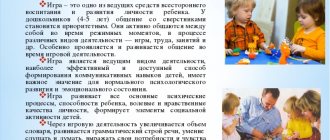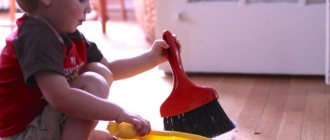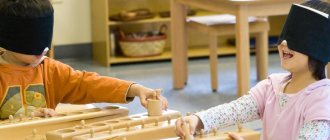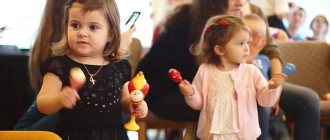Features of the emotional development of preschool children
According to P.A. Uruntaeva, a characteristic feature of feelings is their polarity as the simplest experience of pleasure - displeasure. Feelings have varying degrees of duration and intensity. They differ in genetic origin, depth, consciousness, dynamics of development, impact on the body, direction, method of expression, conditions of emergence and disappearance, and so on. Feelings have external expression in expressive movements of the face (facial expressions) and body (pantomime), in the intonation of speech.
Depending on the form of the flow, a sensual tone, mood, emotions themselves, passions, stress, disappointment, higher feelings arise. The highest product of human emotions is stable feelings towards objects that satisfy his highest needs. Higher feelings have a pronounced object character, since they are associated with a specific object. Depending on the subject area to which they relate, they are divided into moral, aesthetic and intellectual. Morality is experienced by a person in the process of perceiving the phenomena of reality and comparing them with the norms developed in society. Intellectual feelings arise in the process of human cognitive activity. Aesthetic feelings are a person’s emotional attitude to beauty in nature, in art, in people’s lives.
The emotional development of a preschool child is primarily associated with the emergence of new interests, motives and needs. The most important change in the field of motivation is the emergence of social motives, which are no longer driven by the achievement of narrowly personal, hidden goals. It has been established that social emotions and moral feelings, which were not present or observed at the embryonic stage, begin to develop intensively in preschool age. The establishment of a hierarchy of motives leads to changes in the emotional sphere.
Eliminating the main motive to which the entire system of others is subordinate stimulates consistent and deep experiences. And they concern not the immediate, immediate, but rather the long-term results of activity. That is, emotional experiences are no longer caused by a directly perceived fact, but by the deep inner meaning that this fact acquires in connection with the guiding motive of the child’s actions. Emotions lose their situational nature and become deeper in their semantic content, arising in response to proposed mental circumstances (P.M. Yakobson). The preschooler develops emotional anticipation, which makes him think about the possible results of his activities and anticipate the reactions of other people to his actions. Therefore, the role of emotions in a child’s activities changes significantly. If previously the child experienced joy from obtaining the desired result, now he experiences joy from the fact that he can get this result. If earlier he fulfilled a moral norm in order to deserve a positive assessment, now he fulfills it in anticipation of how others will be happy with his action.
Thus, a preschool child gradually begins to foresee not only the intellectual, but also the emotional results of his actions. At preschool age, a child masters the highest forms of expression - expressing feelings through intonation, facial expressions, pantomime, which helps him understand the experiences of another person and “discover” them for himself.
So, on the one hand, the development of emotions is determined by the emergence of new motives and their subordination, and on the other hand, emotional anticipation ensures this subordination.
Also from the argumentation of A.D. Kosheleva, it can be argued that changes in the emotional sphere are associated with the development of not only the motivational, but also the cognitive sphere of personality and self-awareness. The involvement of language in emotional processes ensures their intellectualization, when they become more conscious, more generalized. The first attempts to restrain emotions, for example, their external manifestation - tears, can be noticed in a 3-4 year old child. Although kids are still not good at doing this. The older preschooler begins to control the expression of emotions to some extent, influencing himself with words.
Preschoolers have difficulty restraining emotions associated with organic needs. Hunger and thirst make them act impulsively.
Diagnostics
Basic diagnostic methods for the emotional sphere of children:
- testing
- observation
- survey
- conversation
- survey
- analysis of samples of children's creativity (drawings).
When observing a preschooler, pay attention to factors such as emotional background, mood, degree of expression of emotions, level of emotional mobility. By observing, you can easily notice how rich the child’s emotional background is, whether the child knows how to control his emotions, and whether he is characterized by emotional instability.
Using one of the diagnostic methods or in combination, you can find out:
- How adequate is the preschooler’s reaction to phenomena?
- how he perceives and interprets the states and moods of other people
- the breadth of the range of emotions that the child understands and experiences, the depth of his experiences, ways of conveying emotions through speech;
- Is it appropriate to display emotions during communication?
These methods can be used by both professional child psychologists and kindergarten teachers.
Features of the organization of the pedagogical process in a preschool institution
Preschool age is a bright, unique page in the life of every person. At this time, the process of socialization begins, which establishes the child’s connection with the leading spheres of life: the human world, nature and the material world. The child is introduced to culture and universal values. The child lays the foundation for his health. Preschool childhood is the time of the first formation of personality, the formation of the foundations of self-confidence and individuality of the child.
The goal of such upbringing is not to accelerate the child’s development as much as possible, not to force the timing and pace of his transition to the “rails” of school age, but, first of all, to create conditions for the fullest development of the age-related capabilities and abilities of each preschooler.
In preschool age, the process of cognition occurs in the child in an emotional and practical form. Every preschool child is a little explorer who explores the world around him with joy and surprise. The child strives to be active, and it is important not to let this desire fade in order to promote his further development. The more complete and varied the child’s activity, the more significant it is for him and corresponds to his nature, the more successful his development, the more his potential and initial creative development are realized.
It is rightly noted that the main task of the educator is to fill the daily life of preschoolers with interesting activities, problems and ideas, to involve each child in meaningful activities, to promote the realization of children’s interests and their vital activity. By organizing children's activities, the teacher develops in each child the desire to take initiative and find a reasonable and worthy way out of various life situations.
When organizing the pedagogical process in kindergarten, the question of the specifics of pedagogical and educational work with preschool children is of great importance.
Preschool education contains tasks that have not only educational, but also pedagogical value. These tasks include the formation of correct ideas about the world around us, the development of language, arithmetic and the acquisition of drawing, modeling skills, etc.
A significant number of forms and resources have been developed for pedagogical work with preschoolers, including activities, didactic games and materials. Each of these resources has different capabilities in terms of educational and educational tasks.
Preschool pedagogy selectively approaches the means of educational work with children, in accordance with the tasks of the kindergarten, based on the requirements of active management of the development of each child to ensure a high level of comprehensive development of all children in kindergarten.
Among the means of educational work in a preschool institution, teaching has a great advantage, since it provides an organized teaching role for an adult, which makes teaching very effective.
Teaching applied to a range of educational contents, namely: environmental studies, language learning, development of mathematical concepts, musical skills, movement development, drawing, sculpting and so on, has a profound educational impact on children, develops their abilities and interests, expands horizons, enriches skills in various activities and improves attention. Education makes it possible to raise the development of all children in a group to a higher level and significantly contributes to mitigating the uneven development of children observed in practice.
Stages and methods of experimental research
To confirm the theoretical provisions of the study in practice, we organized experimental work. Conventionally, it can be divided into three main stages.
The first stage is research.
At this stage, based on the analysis of psychological and pedagogical literature and data from our own experience of working in preschool institutions, the following was done:
- Formation of a research hypothesis;
- Determination of research tools;
- Selection and study of the experimental group.
The methodological apparatus of the research is a combination of methods: Questioning, testing, observation, analysis of activity products.
The testing method is the most important. We used tests published in the psychological literature. In particular, we used a special drawing test “Family Drawing”.
This test can be administered to children as young as five years old. It is based on the recognition that children evaluate the behavior of their parents in their own way, seem different to adults, perceive events differently than we do, and make conclusions different from us. Children's special observations cause emotional reactions that adults do not understand or accept. In the child’s inner world, seemingly incompatible, random things are woven together, fantastic images, their own “theories” and versions arise. Children use them as a basis for their original behavior.
Historically, the use of the Family Drawing technique is associated with the general development of “projective psychology.” The growth of interest in drawing techniques was fueled by the publication of fundamental monographs on this technique by K. Machover (1949) and J. Buck (1948). Drawing techniques became very popular among psychological practitioners in the 1950s and 1960s. In the 60s, this technique quickly spread among clinical psychologists, and in different geographical regions different names (in the USA - V. Hulse, in France - I. Minkowski, M. Moreau, etc.) are associated with priority in its use . E. Hamer (1958) puts it this way: “It was probably, like many worthwhile inventions, born simultaneously in the minds of different people.” However, R. Burns and S. Kaufman (1972) note that the earliest mention in the literature of the use of a family drawing belongs to W. Hume (1951). Without going into details, it should only be used for these purposes before. We can talk about a developed system of analysis and interpretation of family drawings, starting with the work of V. Wolf (1947). This researcher attached exceptional importance to the influence of the family on personality development in preschool age and developed a set of techniques for assessing intrafamily relationships. While drawing, he analyzed:
(a) the order of drawing family members, their spatial arrangement, omission of family members in the drawing;
(b) differences between graphic images in shapes, proportions.
V. Wulf notes that the order in drawing may indicate the importance of the role of the persons drawn in the family. The child draws from more significant to less significant. The author notes that the omission of family members is a rare occurrence and that there is always some motive behind it. Often this expresses a desire to reduce an emotionally unacceptable family member, to get rid of him. As for the characteristics of the characters, the author emphasizes their scale. If the actual situation does not match the size ratio in the picture, this indicates that the size is determined by mental factors rather than reality. Differences in the pattern of individual body parts can also be indicative.
In general, W. Wolf (1947) developed those features of the drawing that would later become the subject of interpretation by other authors.
The novelty of V. Hulse's work (1951, 1952) lies in the analysis of the drawing process (use of pencils, erasing drawings, crossing out, doubts, emotional reactions, spontaneous comments). These data provide additional information about the child’s attitude to the drawn details and his general emotional state.
When is personality born?
Features of the emotional sphere of a preschooler are manifested in awareness of one’s own personality, activity, activity and objective assessment of oneself. At the same time, a subordination of motives is formed. It indicates that the child is already able to subordinate immediate impulses to more conscious goals.
An indicator of correct development is the ability to manage behavior, control the implementation of assigned tasks and the ability to minimally foresee the result of activity or lack thereof.
What does the correct development of the emotional-volitional sphere of a preschooler lead to? Once uncontrollable emotions and feelings become subordinated to thinking.
The emotional sphere undergoes serious changes with speech and physical development. Outlooks on life and relationships with the outside world are being reformatted globally. What should parents do? They must understand that their child is an individual whose formation takes place with gradual adjustment.
The development of the volitional sphere of a preschooler aged 2-4 years requires a gradual approach. It is important to realize that at this age children often show the full range of negative emotions with loud tantrums, tears and screams.
At the age of 4-5 years, emotions are ruled by the desire for independence, however, difficult situations, fatigue, and emotional overexcitability can lead to the fact that the child’s behavior will exhibit traits that are characteristic of younger peers. The occurrence of such a situation should be a signal to adults: too much has fallen on the child, he cannot bear it. All you need is comfort, affection, care and permission to behave like a little one.
Should a child's bad mood always cause concern for parents? No! A preschooler is subject to feelings; he is unable to correctly and constantly manage his experiences. It is this feature that explains the constant change of mood and a whole range of feelings that arise in a short period of time. Striking laughter can give way to bitter tears and hysterics; such behavior in children is considered absolutely normal.
The development of a stable emotional state directly depends on social situations. Changes in the usual way of life and routine can cause affective reactions and fear. The personality responds to the dissatisfaction of new needs with a state of frustration, which is expressed by rage, aggression and depression.








